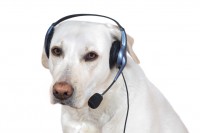May You Say No to Your Dog?
By Jerry D. Patillo, CPDT-KA
© 2016 Phoenix Behavior Consulting
 Yes! Of course, you may say “No!” to your dog. You may say “No! No! No!” to your dog all day long. The problem is, if you don’t change YOUR behavior, how in the world do you expect your dog’s behavior to change?
Yes! Of course, you may say “No!” to your dog. You may say “No! No! No!” to your dog all day long. The problem is, if you don’t change YOUR behavior, how in the world do you expect your dog’s behavior to change?
When you’re addressing undesirable behaviors, there are always TWO steps:
- Remove the reward of the behavior you don’t like.
- Teach your dog what you want it TO DO instead.
Saying “No!” to your dog does not accomplish either one of the above two steps.
Step #1
Remove the reward of the behavior you don’t like.
What’s a reward for a dog? Anything your dog likes, anything your dog wants, anything your dog needs can be a reward for the behavior that preceded it. What is your dog trying to accomplish or trying to get with its behavior?
E.g., why do dogs jump on us?
- To say hello to us
- To get our attention
- To get picked up
- To see what we’re carrying
- To knock the items we’re carrying out of our hands (Maybe there’s food up there!)
- So many other reasons
When a 5-pound (2 kg) puppy jumps on us, it’s really cute. However, when that 5-pound puppy grows into a 50-pound (25 kg) puppy – or a 150-pound (75 kg) puppy — it’s not so cute anymore.
So Step #1 is to remove the reward of the behavior you don’t like.
Step #2
Teach your dog what you want it TO DO instead.
Using jumping as an example, what do you want your dog to do instead? “Anything except jumping on me,” you may say. “Okay,” I may reply. “So, chewing on your couch is better than jumping on you?” Obviously, no. The idea is, what do you want your dog TO DO instead of the undesirable behavior?
Again using jumping as an example, what do you want your dog to do instead? How about:
- Sit
- Down (lie down)
- Go to your crate
- Do backflips (suggested by a 10-year-old student!)
- So many other ideas
If you don’t want your dog to jump on you, what do want it to do instead?
I like Sit.
Every time your dog approaches you or another person, have it Sit. Every time. Every time you or another person approaches your dog, have it Sit. Every time.
What becomes routine for you will become routine for your dog. What becomes habit for you will become habit for your dog. Guess what. If you don’t have a routine, your dog won’t have a routine either!
Step #2 is, teach your dog what you want it TO DO instead of the undesirable behavior.
 If you need help with addressing undesirable behaviors, please contact us today. We can help!
If you need help with addressing undesirable behaviors, please contact us today. We can help!